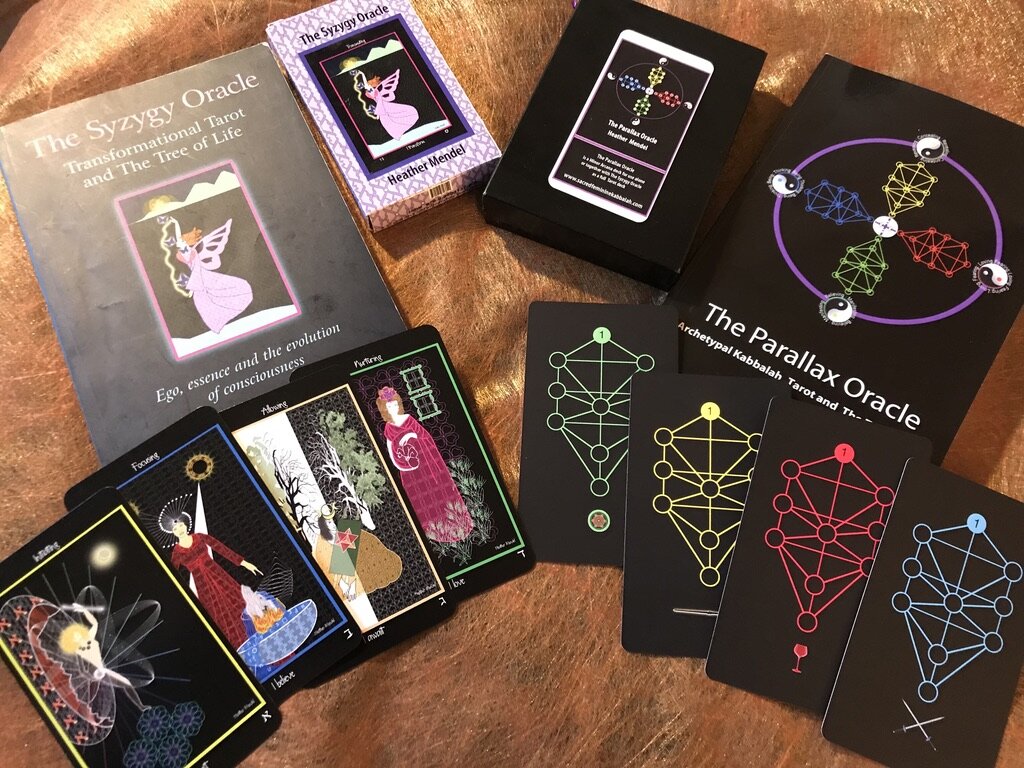Survey of Kabbalistic Tarot Decks, Part 3: The Parallax & Syzygy Oracles
/When I began to specialize in Kabbalistic tarot 15 years ago, I also started collecting tarot decks that are explicitly structured on Kabbalistic principles—whether the underlying structure is Hermetic Qabalah or Judaic Kabbalah. I wrote about two of these decks previously: Edward Hoffman’s Kabbalah Deck, and Ron Feldman’s Kabbalah Cards. And both of these decks are pure Judaic Kabbalah. Today I’d like to look at Heather Mendel’s Parallax Oracle, which serves as a Minor Arcana companion to her earlier Syzygy Oracle, a deck of Majors.
Since the Syzygy Oracle came first, I’ll begin with this deck. One of the issues many people have with the Judeo-Christian tradition is that it is very patriarchal. And while that has changed within Judaism over the last two decades, with the ordination of women as rabbis, and a reading in to the women in the Torah, there’s no getting around the fact that from Adam to Moses, it’s the men who get the attention. So I was happy to see that the Syzygy Oracle, while working from an underlying Kabbalistic structure, did not rely on male Biblical figures to represent the archetypal energies of the Major Arcana.
The Majors of the Syzygy Oracle work to capture the energies of the Divine Feminine in the full range of its expression—and to do this Mendel chose to go outside the tradition. So unlike the decks by Feldman and Hoffman, which only use the Hebrew letter designations to represent each Major, Mendel has chosen representations of the Divine Feminine from multiple traditions: from Artemis to Kwan Yin. Each of these goddesses capture the essence of each card’s transformational energy. And Mendel draws the connections between meanings of the Hebrew letter designations for each card, and the female figures she has chosen (except for the Emperor, who is unquestionable male).
I was interested in working with this deck because my birth cards are The High Priestess and Justice—both female figures in the traditional decks. I’ve always felt my connection to Justice, but I have also felt that I need a better relationship to the High Priestess. Working with the Syzygy Oracle gave me a clear path to work with the anima and this card.
I found working with each card and working with the practices she recommends in the accompanying book, deepened my understanding of the High Priestess and helped my come into a better relationship with the card and its energy.
The Syzygy Oracle deck also included another ten cards over and above the majors, to represent the ten Sephirot. But this was the place where I wanted more. And I’m glad to say that Mendel has created the companion Parallax Oracle, which covers the Minors.
In this deck, we move from the anthropomorphic (“anthro” means male though, so what’s the female equivalent for this word?) to the more abstract. Not unlike the Hoffman and Feldman decks, Mendel has chosen to use the diagram of the Tree of Life for each card—though unlike those other decks, where, say a card might have the designation of Chesed in Atzilut, in the Parallax Oracle, while the image is of the Tree of Life Diagram, the number of the Sephira is noted, not the name. Each suit is color coded and has its symbol discreetly positioned at the bottom of the card, so that you’d know immediately if you pulled the Chesed in Atzilut card that you have the Four of Wands in your hand.
This makes learning the Kabbalistic understructure of tarot immediately apparent, and easily accessible. What’s more, in her accompanying text, as she did in the Syzygy Oracle, Mendel puts each card along a continuum in the journey to wholeness on several different levels. She makes a direct connection with the cards and stages on the path of the mythic hero’s journey. Kabbalah and the teachings of Jung have often been noted by scholars. And Jung himself wrote about tarot. Mendel brings it all together seamlessly in a way that is relevant to the lives we live today, and the life we aspire to.
Working with these two decks together will give you a strong foundation in understanding the Kabbalistic structure of tarot. You’ll learn many of the traditional Judaic meanings around these energies, and you’ll see how working with these cards will give greater depth to the meanings of cards in any Golden Dawn derivative deck.
Mendel’s knowledge is wide-ranging, yet her focus is entirely on tarot as a tool for greater self-awareness and evolutionary consciousness. And she succeeds admirably. For those who work with the Golden Dawn derivative decks (Waite-Smith, Thoth, B.O.T.A. and their children) both the Syzygy and Parallax Oracle decks provide an accessible understanding their Kabbalistic structure and a wealth of new insights on the journey.

